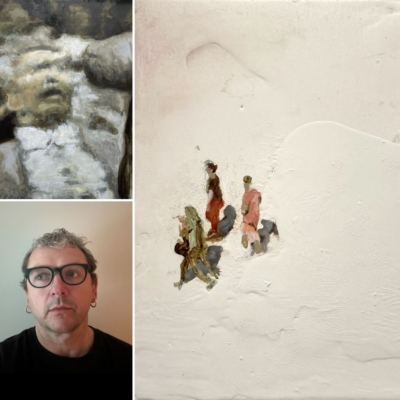Run, don’t walk to see two Caravaggio masterpieces reunited at Ulster Museum Belfast as part of the National Gallery’s 200-year anniversary. Here’s why they are so significant …
If you watched Steven Zaillian’s acclaimed adaptation of Patricia Highsmith’s novel, The Talented Mr Ripley, you will know that the director placed great importance on the work of the Milanese artist, Michelangelo Merisi de Caravaggio (1571-1610).
Across the eight episode Netflix show Ripley, the anti-hero Tom Ripley (played by Andrew Scott) becomes a Caravaggio fan, circling the artist’s must-see works in every city he visits, buying a catalogue of his works which he peruses in his Venetian palazzo. Via Ripley, the audience is introduced to Caravaggio’s biblical commissions, including the “The Seven Works of Mercy” (in episode 2), “The Inspiration, The Calling and The Martyrdom of Saint Matthew” (in episode 4) and “The Calling of Saint Matthew” (in episode 8).

Zaillian was clearly influenced by Caravaggio’s realism and the techniques he deployed in his paintings to dramatic effect: chiaroscuro (meaning light-dark) and tenebrism (meaning darkened and obscure). The show’s black and white cinematography uses light and shadow to capture the elegance of Italy so well.
If you have been inspired by Ripley, and are interested in learning more about Caravaggio, an exhibition featuring two of his paintings rarely seen together since the 17th century is currently on at The Ulster Museum. It’s a significant and historic cultural moment. Caravaggio’s “The Last Supper of Emmaus” is on loan from the National Gallery London as part of its National Treasures project marking its bicentenary. Additionally, the Jesuit Community in Dublin, with the support of the National Gallery of Ireland, has facilitated the loan of “The Taking of Christ”.

Dr Aoife Brady, curator of Italian and Spanish art at the National Gallery of Ireland, explains more about Caravaggio, who has a fascinating backstory and has often been regarded as a bit of a scoundrel.
“Born in 1571 in the region of Lombardy, northern Italy, Michelangelo Merisi earned the nickname Caravaggio after the small town in which he grew up, about 50kms east of Milan. He grew up in poverty, and moved to Rome in 1591 in search of a career as a painter, with little more than the clothes on his back. He quickly established a reputation there, receiving important private and public commissions. He pioneered a new extreme naturalism that involved using dramatic contrasts of light and shade, and live models as the basis for religious scenes. At first, this was seen as shocking, even sacrilegious, but quickly people came to recognise how effective Caravaggio’s work was at conveying intense emotions and dramatic narratives.
“His reputation wasn’t all positive, however: he had an infamously bad attitude that got him in trouble regularly. In 1606, he was forced to flee Rome on a murder charge, and spent much of the remainder of his life on the run. His legacy was incredibly far reaching, influencing countless artists that came after him. His use of naturalism, bold lighting effects, and his uncanny ability to suspend a moment in time sent shockwaves through Europe which can still be felt in the modern day, inspiring filmmakers such as Francis Ford Coppola and Martin Scorsese centuries later.

Caravaggio Merisi da Michelangelo, 1571–1610, “The Taking of Christ”, 1602.
On indefinite loan to the National Gallery of Ireland from the Jesuit Community, Leeson Street, Dublin, who acknowledge the kind generosity of the late Dr Marie Lea-Wilson, 1992. Image; National Gallery of Ireland.
“The Taking of Christ” has been described in the past as the darkest and densest of all Caravaggio’s works. In this foreboding painting Caravaggio created a scene almost entirely in shadow, casting luminous moonlight over faces, hands, and the shining armour of the foremost soldier to guide our eye around the canvas and tell a story. It recounts the pivotal event in the Bible that took place shortly after the Last Supper when, late at night, Judas identified Jesus with a kiss, before a group of soldiers moved in to arrest him.
From left to right in Caravaggio’s crowded composition we see Saint John the Evangelist – fleeing the scene, as a soldier grips his red cloak – then Jesus, Judas, three soldiers (the helmet and eyes of the third is just barely visible in the background) and a man holding a lantern and peeking over the heads of the others. This is, in fact, a self-portrait of the artist himself, aged 31. Caravaggio inserts himself as the illuminator of the scene, as well as an onlooker to this biblical event, encouraging us as viewers to engage in the unfolding drama just as he does. Recognised as one of the artist’s greatest masterpieces, the painting was lost for centuries until it was rediscovered by the National Gallery of Ireland’s former Head of Conservation, Sergio Benedetti, in the Jesuit’s House on Leeson Street, Dublin, in 1990. This is often described as one of the greatest art-historical discoveries of the 20th century.

Michelangelo Merisi da Caravaggio, 1571 – 1610, The Supper at Emmaus, 1601. Presented by the Hon. George Vernon, 1839 © The National Gallery, London.
“The London and Dublin canvases shared a home long before they came together again in 2024. Both were painted in the initial years of the 1600s for the same patron, the Roman Marquis Ciriaco Mattei, and originally displayed in the Mattei family palazzo in Rome. Together, they represent two key events preceding Christ’s Crucifixion and his later Resurrection, as narrated in the Gospels: “The Taking of Christ” illustrates his late-night arrest in the garden of Gethsemane, while “The Supper at Emmaus” depicts an event that occurred three days after the Crucifixion, when disbelieving disciples encounter their resurrected leader.
“Such biblical subject matter was not new in the 17th century, but Caravaggio’s interpretation certainly was. Like a modern-day photographer, his canvases suspend a single moment in time to great dramatic effect, capturing the tension immediately prior to Judas’s kiss of betrayal in “The Taking of Christ”, and the shock on the faces of the disciples in “The Supper at Emmaus” in the precise instant in which they recognised the returned Christ. Painting close to life-size, Caravaggio cropped both compositions and pressed his protagonists close to the picture plane, giving the viewer the impression that they themselves are involved in the unfolding drama.”
The Ulster Museum’s “Discover Caravaggio” art space has been a hit with families especially. Dr Brady believes this is because Caravaggio’s works are universally accessible. “He painted real people in such a way that we encounter them today as living, breathing human beings. He often painted his characters as life size, meaning that we can interact with them – Caravaggio’s viewers are not just an audience, but participants. So, whether young or old, I would suggest just spending some time looking at the painting, and watching how a story unfolds through gestures and expressions.”
Need to Know: “The Supper at Emmaus” and “Taking of Christ” are on display until Sunday September 1 at the Ulster Museum, Belfast. For more information visit www.ulstermuseum.org. If you need more help getting children interested in art, the National Gallery of Ireland’s Education Department regularly hosts free tours for families and new parents – you can find out more at www.nationalgallery.ie.









